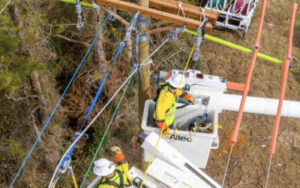
In the ever-evolving world of telecommunications, aerial splicing plays a crucial role in ensuring reliable and efficient connectivity. This process involves the joining and enclosing of fiber optic cables in overhead lines, allowing seamless transmission of data and voice signals across networks. To accomplish this task, telecom companies in Houston rely on the expertise of specialized contractors who possess the necessary skills and knowledge in aerial splicing techniques.
Understanding Aerial Splicing in Telecom
Aerial splicing plays a pivotal role in the telecom industry, bridging the gap between various communication networks. It involves the careful fusion of fiber optic cables to ensure minimal signal loss and maximum data transfer capabilities. Aerial splicing is particularly essential in Houston, where the city’s expansive urban landscape demands innovative methods to connect communities effectively.
The Importance of Aerial Splicing in Telecom
Uninterrupted connectivity has become a basic necessity, both in personal and business environments. Aerial splicing allows telecom companies to meet these demands by efficiently connecting homes, offices, and public spaces to their expansive networks. By ensuring seamless communication, aerial splicing enables individuals and businesses to stay connected, allowing for uninterrupted workflows, enhanced productivity, and improved quality of life.
The Process of Aerial Splicing
The process of aerial splicing begins with the careful selection of fiber optic cables to ensure compatibility and optimal performance. These cables are then prepared for splicing by removing any protective layers and cleaning the fiber ends to ensure a pristine connection. Next, specialized equipment is used to fuse the fiber optic cables, creating a seamless and durable joint. Finally, the spliced cables are enclosed in protective cases to shield them from external elements such as moisture, UV radiation, and physical damage.
When it comes to aerial splicing, precision and attention to detail are paramount. Telecom technicians undergo rigorous training to master the art of splicing, ensuring that each connection is flawless. They meticulously handle the delicate fiber optic cables, using specialized tools and techniques to achieve optimal results.
Furthermore, the process of aerial splicing requires careful planning and coordination. Telecom companies work closely with city officials and urban planners to identify the best locations for aerial splicing. Factors such as accessibility, proximity to existing infrastructure, and environmental considerations are taken into account to ensure the most efficient and effective network expansion.
In addition to its technical aspects, aerial splicing also contributes to the visual aesthetics of the urban landscape. Telecom companies invest in designing and implementing aesthetically pleasing enclosures for the spliced cables. These enclosures blend seamlessly with the surroundings, minimizing visual impact while ensuring the protection and longevity of the spliced cables.
The Role of Contractors in Telecom Aerial Splicing
Achieving efficient aerial splicing requires the expertise of specialized contractors who possess the skills, experience, and knowledge required for the task at hand. Telecom companies in Houston rely on these contractors to ensure the reliable and seamless connection of their networks.
Skills Required for Aerial Splicing Contractors
Aerial splicing contractors possess a unique skill set that enables them to handle the intricacies of this specialized field. They must have a comprehensive understanding of fiber optic technology, as well as the ability to interpret network plans and blueprints accurately. Additionally, contractors must possess excellent hand-eye coordination and manual dexterity, as well as strong problem-solving skills to troubleshoot any issues that may arise during the splicing process.
Responsibilities of Aerial Splicing Contractors
Aerial splicing contractors have a wide range of responsibilities that encompass the entire splicing process. From initial cable preparation to the final enclosure of the spliced cables, contractors must meticulously execute each step to ensure optimal performance and durability. Additionally, contractors are responsible for adhering to safety protocols, ensuring compliance with industry regulations, and documenting their work for future reference and maintenance purposes.
Choosing the Right Aerial Splicing Contractor in Houston
When it comes to hiring an aerial splicing contractor in Houston, telecom companies must consider various factors to ensure they make the right choice.
Factors to Consider When Hiring a Contractor
One crucial factor to consider is the contractor’s experience and track record in aerial splicing. A proven track record demonstrates their ability to deliver efficient and reliable results. Companies should also evaluate the contractor’s certifications and qualifications to ensure they possess the necessary expertise to handle the task. Additionally, considering references and testimonials from previous clients can provide valuable insights into the contractor’s professionalism and reliability.
The Benefits of Hiring Local Contractors
Choosing local contractors in Houston offers several advantages for telecom companies. Local contractors possess a deep understanding of the unique challenges and regulations specific to the area. They are familiar with local infrastructure, permits, and any potential obstacles that may arise during the splicing process. Additionally, hiring local contractors promotes community engagement and supports the local economy.
Future Trends in Telecom Aerial Splicing
The field of aerial splicing in telecommunications is continually evolving as new technologies emerge and demand for faster, more reliable connectivity continues to grow.
Technological Advancements in Aerial Splicing
Advancements in aerial splicing technology have led to more efficient and precise methods of connecting fiber optic cables. Improved fusion splicers, specialized tools, and automated processes have streamlined the aerial splicing process, reducing installation time and increasing overall network performance. These advancements allow telecom companies to meet the increasing demand for high-speed internet and advanced communication services.
The Impact of 5G on Aerial Splicing
As 5G technology becomes more widespread, the demand for aerial splicing services will likely surge. 5G networks require dense fiber optic infrastructure to support the increased bandwidth and connectivity demands. Aerial splicing contractors will play a vital role in expanding and upgrading the existing networks to accommodate 5G technology, ensuring widespread access to faster and more reliable communication services.
Regulatory Considerations for Aerial Splicing in Houston
Telecom companies and aerial splicing contractors in Houston must navigate regulatory considerations to ensure compliance and safety.
Understanding Telecom Regulations
Telecommunications regulations vary by region and can dictate proper installation and maintenance procedures. Companies must ensure that their aerial splicing contractors are well-versed in these regulations to avoid penalties and compliance issues. Regular training and updates on regulatory changes are essential to ensure contractors stay informed and follow all required protocols.
Compliance and Safety in Aerial Splicing
Compliance with safety standards is paramount in aerial splicing to protect both the technicians and the general public. Contractors must adhere to safety protocols, utilize proper protective equipment, and follow industry best practices to minimize the risk of injuries and accidents. Regular safety audits and assessments should be conducted to identify and address any potential hazards.
In conclusion, aerial splicing is a critical aspect of the telecom industry, enabling seamless connectivity and communication between networks. Houston telecom companies rely on specialized contractors to execute aerial splicing projects efficiently and ensure optimal network performance. By considering factors such as experience, qualifications, and local knowledge, telecom companies can choose the right contractor for their specific needs. As technology advances and new regulations emerge, aerial splicing will continue to play a vital role in expanding networks and meeting the growing demand for faster and more reliable communication services.
When it comes to expert aerial splicing services that meet the demands of today’s telecommunications industry, look no further than Whitmore Construction. With our extensive experience and commitment to safety, quality, and customer service, we are equipped to handle your utility construction needs on a local, regional, or nationwide scale. Our turn-key network services are designed to support the complete range of Fiber to the Home (FTTH) network deployments, ensuring your project’s success with our knowledgeable aerial construction team. Whether you require new construction, repairs, or maintenance for your telecom infrastructure, Whitmore Construction stands ready with a team of professionals who are experienced, trained, and fully compliant with all state regulations. Contact Us Today! to discover how we can bring our wealth of knowledge and resources to your next project, ensuring the implementation, maintenance, and integrity that your network deserves.
